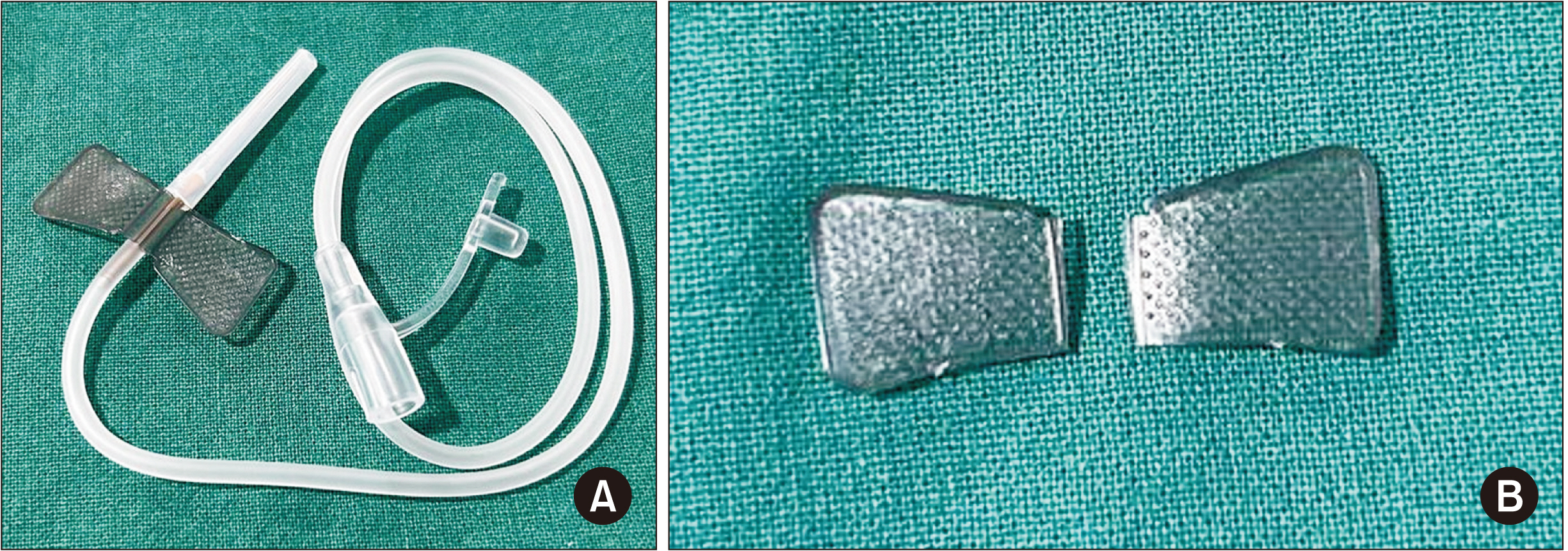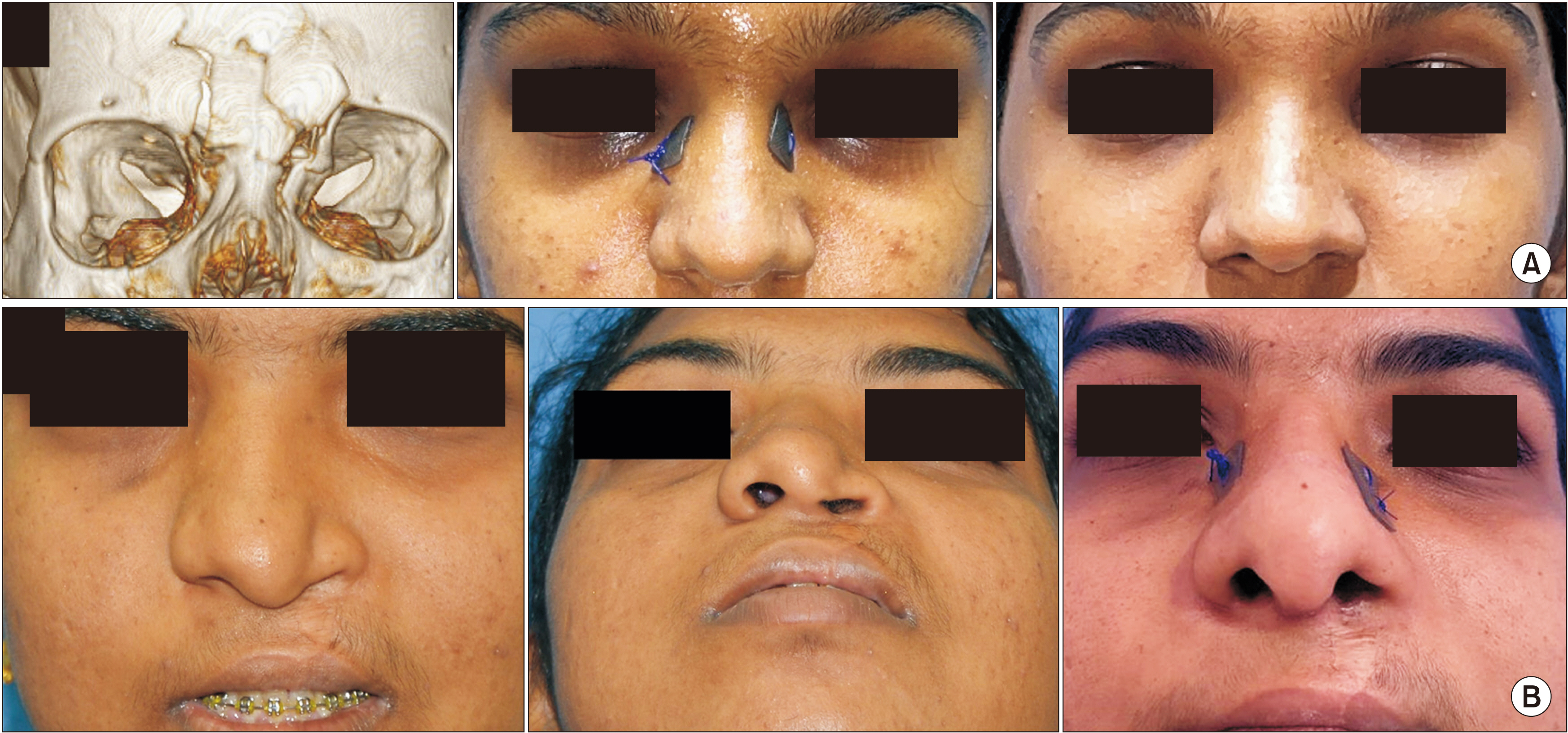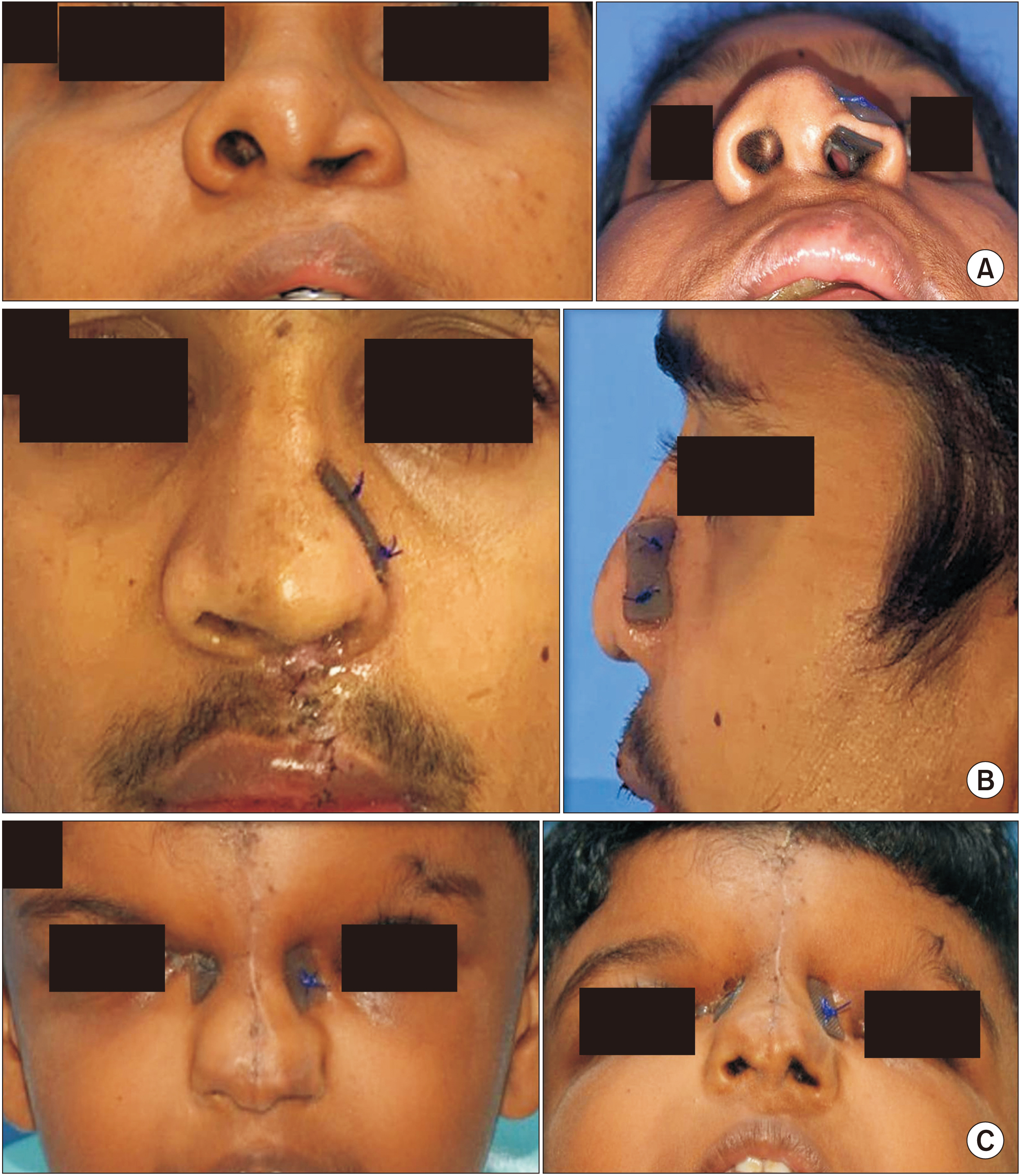J Korean Assoc Oral Maxillofac Surg.
2024 Apr;50(2):116-120. 10.5125/jkaoms.2024.50.2.116.
Intravenous catheter flanges as an external nasal stent: a novel technique
- Affiliations
-
- 1Department of Cleft & Craniomaxillofacial Surgery, Amrita Institute of Medical Sciences, Kochi, India
- 2Department of Head & Neck Surgery, Amrita Institute of Medical Sciences, Kochi, India
- 3Department of Plastic & Reconstructive Surgery, Amrita Institute of Medical Sciences, Kochi, India
- KMID: 2555742
- DOI: http://doi.org/10.5125/jkaoms.2024.50.2.116
Abstract
- External nasal splints are commonly used for immobilization following nasal fracture reduction or rhinoplasty procedures. The literature documents the use of various materials like thermoplastic materials, aluminum, Orthoplast, fiberglass, plaster of Paris, and polyvinyl siloxane. These materials are bulky, time-consuming, expensive, and cumbersome to use, and have been associated with complications including contact dermatitis and epidermolysis. Furthermore, they cannot be retained if the situation warrants prolonged stabilization and immobilization. We introduce a new technique using readily available scalp vein catheter flanges as an external nasal stent. The technique is easy to master, inexpensive, and limits edema and ecchymosis, while stabilizing the reconstructed nasal skeleton in position during the healing period.
Keyword
Figure
Reference
-
References
1. Schoinohoriti O, Igoumenakis D, Rallis G. 2017; Fractures of the nasal bones: is external splinting really warranted? J Craniofac Surg. 28:e760–3. https://doi.org/10.1097/scs.0000000000003936. DOI: 10.1097/SCS.0000000000003936. PMID: 28930926.
Article2. Auclair E, Noel W. 2018; [Customized external nasal splint after rhinoplasty, introduction to the "tissu-modelage"]. Ann Chir Plast Esthet. 63:155–9. French. https://doi.org/10.1016/j.anplas.2017.06.002. DOI: 10.1016/j.anplas.2017.06.002. PMID: 29191426.
Article3. Matti BA, Nicolle FV. 1986; Use of Orthoplast as nasal splint. Br J Plast Surg. 39:414–6. https://doi.org/10.1016/0007-1226(86)90058-5. DOI: 10.1016/0007-1226(86)90058-5. PMID: 3730694.
Article4. Ahn MS, Maas CS, Monhian N. 2003; A novel, conformable, rapidly setting nasal splint material: results of a prospective study. Arch Facial Plast Surg. 5:189–92. https://doi.org/10.1001/archfaci.5.2.189. DOI: 10.1001/archfaci.5.2.189. PMID: 12633213.
Article5. Jayakumar NK, Rathnaprabhu V, Ramesh S, Parameswaran A. 2016; Polyvinyl siloxane: novel material for external nasal splinting. Int J Oral Maxillofac Surg. 45:57–9. https://doi.org/10.1016/j.ijom.2015.08.984. DOI: 10.1016/j.ijom.2015.08.984. PMID: 26454773.
Article6. Erdogan MM, Simsek T, Ugur L, Kazaz H, Seyhan S, Gok U. 2021; The effect of 3D-printed custom external nasal splint on edema and ecchymosis after rhinoplasty. J Oral Maxillofac Surg. 79:1549.e1–7. https://doi.org/10.1016/j.joms.2021.02.027. DOI: 10.1016/j.joms.2021.02.027. PMID: 33757742.
Article7. Challita R, Shouman M, Ghanime G. 2019; Rhinoplasty and external nasal splinting: is it really a must? Plast Reconstr Surg Glob Open. 7:e2374. https://doi.org/10.1097/gox.0000000000002374. DOI: 10.1097/GOX.0000000000002374. PMID: 31592389. PMCID: PMC6756671.
Article8. Naik SM, Naik SS. 2011; A study of external nasal splints used in nasal bone fractures and rhinoplasties. Clin Rhinol Int J. 4:9–14. https://doi.org/10.5005/jp-journals-10013-1063. DOI: 10.5005/jp-journals-10013-1063.
Article9. Shetty V, Vasishta SM. 2013; Use of acrylic splint for the stabilization of bony components after rhinoplasty: a new technique. J Maxillofac Oral Surg. 12:348–50. https://doi.org/10.1007/s12663-012-0424-0. DOI: 10.1007/s12663-012-0424-0. PMID: 24431867. PMCID: PMC3777030.
Article10. Ash SR. 2003; The importance of polyvinyl chloride in medical devices and the physician's role in the choice of materials. ASAIO J. 49:233–6. https://doi.org/10.1097/01.mat.0000066255.48375.b9. DOI: 10.1097/01.MAT.0000066255.48375.B9. PMID: 12790369.
Article
- Full Text Links
- Actions
-
Cited
- CITED
-
- Close
- Share
- Similar articles
-
- Effectiveness of Anchoring with Balloon Guide Catheter and Stent Retriever in Difficult Mechanical Thrombectomy for Large Vessel Occlusion
- The Effects of Placement of Silicone Tube and e-PTFE Stent in External Dacryocystorhinostomy
- The Footplate Suture Technique for External Nasal Valve Surgery
- Coincidental Occurrence of Acute In-stent Thrombosis and Iatrogenic Vessel Perforation During a Wingspan Stent Placement: Management with a Stent In-stent Technique
- The Shape of Expiratory Nasal Flow





